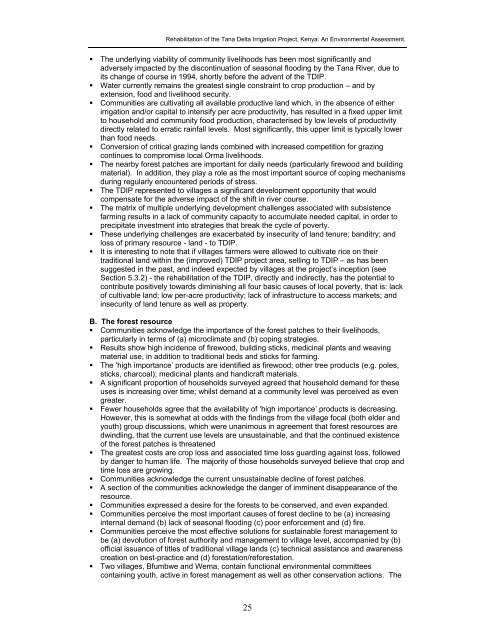Tana Delta Irrigation Project, Kenya: An Environmental Assessment
Tana Delta Irrigation Project, Kenya: An Environmental Assessment
Tana Delta Irrigation Project, Kenya: An Environmental Assessment
You also want an ePaper? Increase the reach of your titles
YUMPU automatically turns print PDFs into web optimized ePapers that Google loves.
Rehabilitation of the <strong>Tana</strong> <strong>Delta</strong> <strong>Irrigation</strong> <strong>Project</strong>, <strong>Kenya</strong>: <strong>An</strong> <strong>Environmental</strong> <strong>Assessment</strong>.<br />
• The underlying viability of community livelihoods has been most significantly and<br />
adversely impacted by the discontinuation of seasonal flooding by the <strong>Tana</strong> River, due to<br />
its change of course in 1994, shortly before the advent of the TDIP.<br />
• Water currently remains the greatest single constraint to crop production – and by<br />
extension, food and livelihood security.<br />
• Communities are cultivating all available productive land which, in the absence of either<br />
irrigation and/or capital to intensify per acre productivity, has resulted in a fixed upper limit<br />
to household and community food production, characterised by low levels of productivity<br />
directly related to erratic rainfall levels. Most significantly, this upper limit is typically lower<br />
than food needs.<br />
• Conversion of critical grazing lands combined with increased competition for grazing<br />
continues to compromise local Orma livelihoods.<br />
• The nearby forest patches are important for daily needs (particularly firewood and building<br />
material). In addition, they play a role as the most important source of coping mechanisms<br />
during regularly encountered periods of stress.<br />
• The TDIP represented to villages a significant development opportunity that would<br />
compensate for the adverse impact of the shift in river course.<br />
• The matrix of multiple underlying development challenges associated with subsistence<br />
farming results in a lack of community capacity to accumulate needed capital, in order to<br />
precipitate investment into strategies that break the cycle of poverty.<br />
• These underlying challenges are exacerbated by insecurity of land tenure; banditry; and<br />
loss of primary resource - land - to TDIP.<br />
• It is interesting to note that if villages farmers were allowed to cultivate rice on their<br />
traditional land within the (improved) TDIP project area, selling to TDIP – as has been<br />
suggested in the past, and indeed expected by villages at the project’s inception (see<br />
Section 5.3.2) - the rehabilitation of the TDIP, directly and indirectly, has the potential to<br />
contribute positively towards diminishing all four basic causes of local poverty, that is: lack<br />
of cultivable land; low per-acre productivity; lack of infrastructure to access markets; and<br />
insecurity of land tenure as well as property.<br />
B. The forest resource<br />
• Communities acknowledge the importance of the forest patches to their livelihoods,<br />
particularly in terms of (a) microclimate and (b) coping strategies.<br />
• Results show high incidence of firewood, building sticks, medicinal plants and weaving<br />
material use, in addition to traditional beds and sticks for farming.<br />
• The ‘high importance’ products are identified as firewood; other tree products (e.g. poles,<br />
sticks, charcoal); medicinal plants and handicraft materials.<br />
• A significant proportion of households surveyed agreed that household demand for these<br />
uses is increasing over time; whilst demand at a community level was perceived as even<br />
greater.<br />
• Fewer households agree that the availability of ‘high importance’ products is decreasing.<br />
However, this is somewhat at odds with the findings from the village focal (both elder and<br />
youth) group discussions, which were unanimous in agreement that forest resources are<br />
dwindling, that the current use levels are unsustainable, and that the continued existence<br />
of the forest patches is threatened<br />
• The greatest costs are crop loss and associated time loss guarding against loss, followed<br />
by danger to human life. The majority of those households surveyed believe that crop and<br />
time loss are growing.<br />
• Communities acknowledge the current unsustainable decline of forest patches.<br />
• A section of the communities acknowledge the danger of imminent disappearance of the<br />
resource.<br />
• Communities expressed a desire for the forests to be conserved, and even expanded.<br />
• Communities perceive the most important causes of forest decline to be (a) increasing<br />
internal demand (b) lack of seasonal flooding (c) poor enforcement and (d) fire.<br />
• Communities perceive the most effective solutions for sustainable forest management to<br />
be (a) devolution of forest authority and management to village level, accompanied by (b)<br />
official issuance of titles of traditional village lands (c) technical assistance and awareness<br />
creation on best-practice and (d) forestation/reforestation.<br />
• Two villages, Bfumbwe and Wema, contain functional environmental committees<br />
containing youth, active in forest management as well as other conservation actions. The<br />
25

















